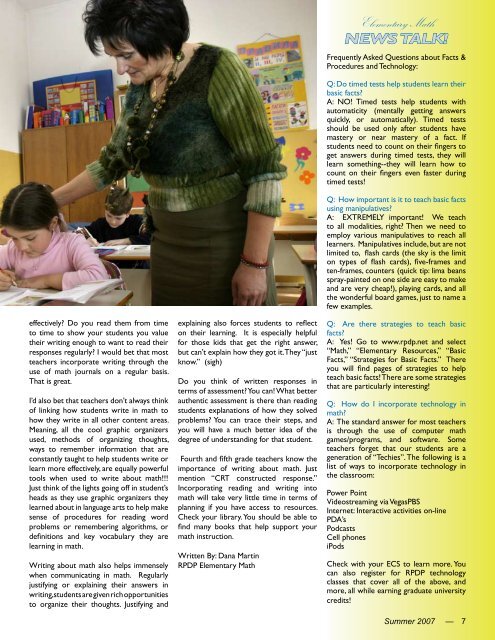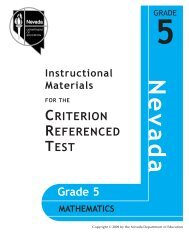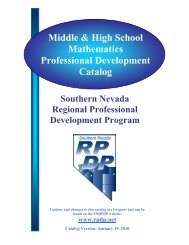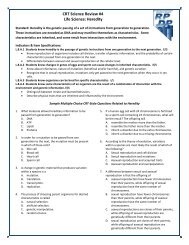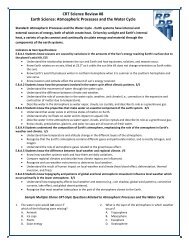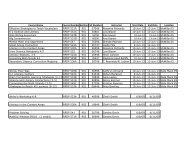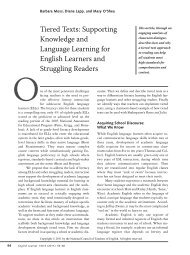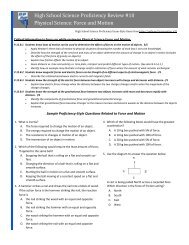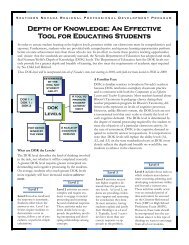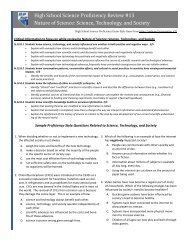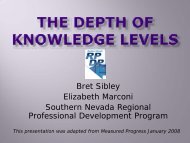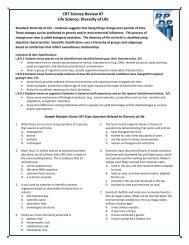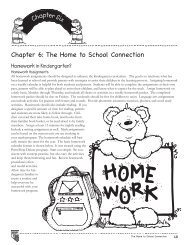Science Proficiency Design - RPDP
Science Proficiency Design - RPDP
Science Proficiency Design - RPDP
You also want an ePaper? Increase the reach of your titles
YUMPU automatically turns print PDFs into web optimized ePapers that Google loves.
effectively? Do you read them from time<br />
to time to show your students you value<br />
their writing enough to want to read their<br />
responses regularly? I would bet that most<br />
teachers incorporate writing through the<br />
use of math journals on a regular basis.<br />
That is great.<br />
I’d also bet that teachers don’t always think<br />
of linking how students write in math to<br />
how they write in all other content areas.<br />
Meaning, all the cool graphic organizers<br />
used, methods of organizing thoughts,<br />
ways to remember information that are<br />
constantly taught to help students write or<br />
learn more effectively, are equally powerful<br />
tools when used to write about math!!!<br />
Just think of the lights going off in student’s<br />
heads as they use graphic organizers they<br />
learned about in language arts to help make<br />
sense of procedures for reading word<br />
problems or remembering algorithms, or<br />
definitions and key vocabulary they are<br />
learning in math.<br />
Writing about math also helps immensely<br />
when communicating in math. Regularly<br />
justifying or explaining their answers in<br />
writing, students are given rich opportunities<br />
to organize their thoughts. Justifying and<br />
explaining also forces students to reflect<br />
on their learning. It is especially helpful<br />
for those kids that get the right answer,<br />
but can’t explain how they got it. They “just<br />
know.” (sigh)<br />
Do you think of written responses in<br />
terms of assessment? You can! What better<br />
authentic assessment is there than reading<br />
students explanations of how they solved<br />
problems? You can trace their steps, and<br />
you will have a much better idea of the<br />
degree of understanding for that student.<br />
Fourth and fifth grade teachers know the<br />
importance of writing about math. Just<br />
mention “CRT constructed response.”<br />
Incorporating reading and writing into<br />
math will take very little time in terms of<br />
planning if you have access to resources.<br />
Check your library. You should be able to<br />
find many books that help support your<br />
math instruction.<br />
Written By: Dana Martin<br />
<strong>RPDP</strong> Elementary Math<br />
Elementary Math<br />
NEWS TALK!<br />
Frequently Asked Questions about Facts &<br />
Procedures and Technology:<br />
Q: Do timed tests help students learn their<br />
basic facts?<br />
A: NO! Timed tests help students with<br />
automaticity (mentally getting answers<br />
quickly, or automatically). Timed tests<br />
should be used only after students have<br />
mastery or near mastery of a fact. If<br />
students need to count on their fingers to<br />
get answers during timed tests, they will<br />
learn something--they will learn how to<br />
count on their fingers even faster during<br />
timed tests!<br />
Q: How important is it to teach basic facts<br />
using manipulatives?<br />
A: EXTREMELY important! We teach<br />
to all modalities, right? Then we need to<br />
employ various manipulatives to reach all<br />
learners. Manipulatives include, but are not<br />
limited to, flash cards (the sky is the limit<br />
on types of flash cards), five-frames and<br />
ten-frames, counters (quick tip: lima beans<br />
spray-painted on one side are easy to make<br />
and are very cheap!), playing cards, and all<br />
the wonderful board games, just to name a<br />
few examples.<br />
Q: Are there strategies to teach basic<br />
facts?<br />
A: Yes! Go to www.rpdp.net and select<br />
“Math,” “Elementary Resources,” “Basic<br />
Facts,” “Strategies for Basic Facts.” There<br />
you will find pages of strategies to help<br />
teach basic facts! There are some strategies<br />
that are particularly interesting!<br />
Q: How do I incorporate technology in<br />
math?<br />
A: The standard answer for most teachers<br />
is through the use of computer math<br />
games/programs, and software. Some<br />
teachers forget that our students are a<br />
generation of “Techies”. The following is a<br />
list of ways to incorporate technology in<br />
the classroom:<br />
Power Point<br />
Videostreaming via VegasPBS<br />
Internet: Interactive activities on-line<br />
PDA’s<br />
Podcasts<br />
Cell phones<br />
iPods<br />
Check with your ECS to learn more. You<br />
can also register for <strong>RPDP</strong> technology<br />
classes that cover all of the above, and<br />
more, all while earning graduate university<br />
credits!<br />
Summer 2007<br />
—


